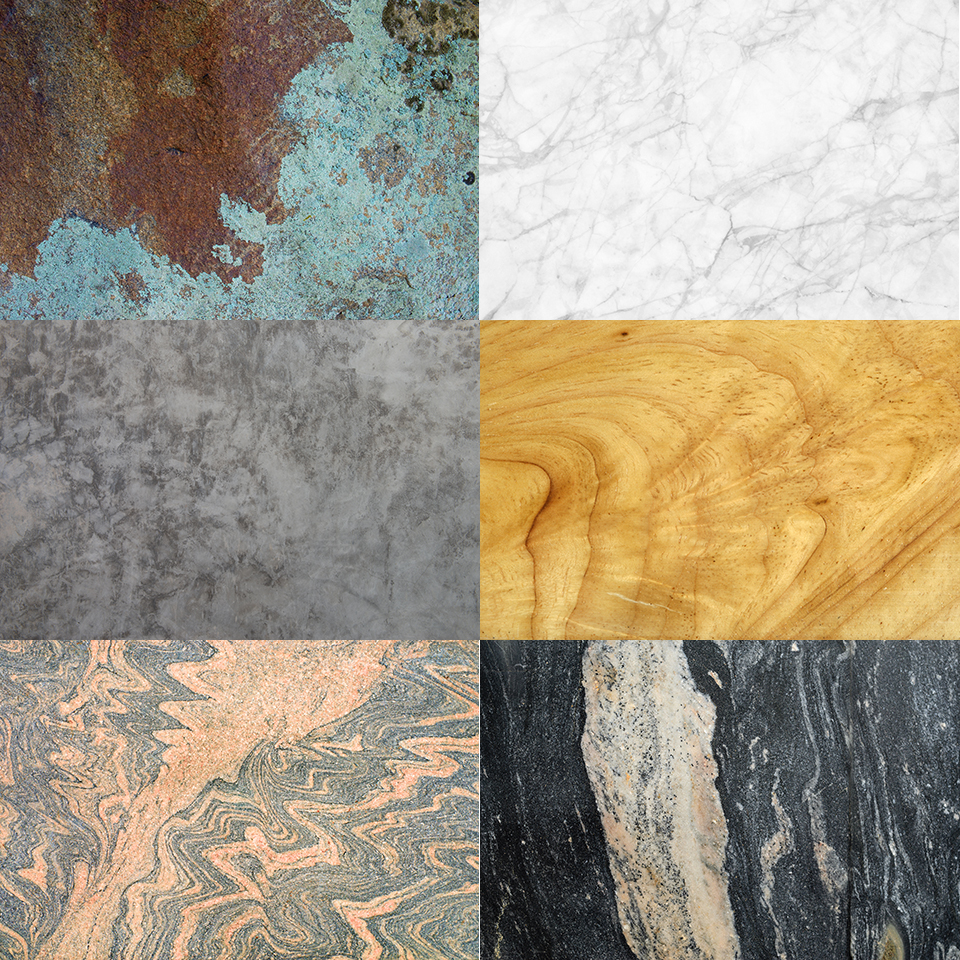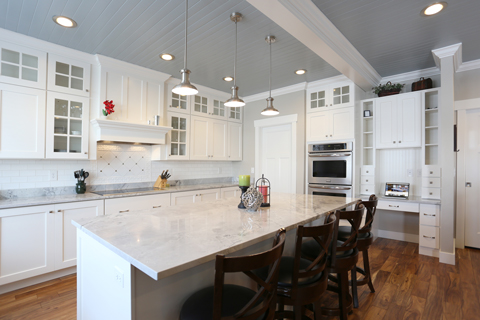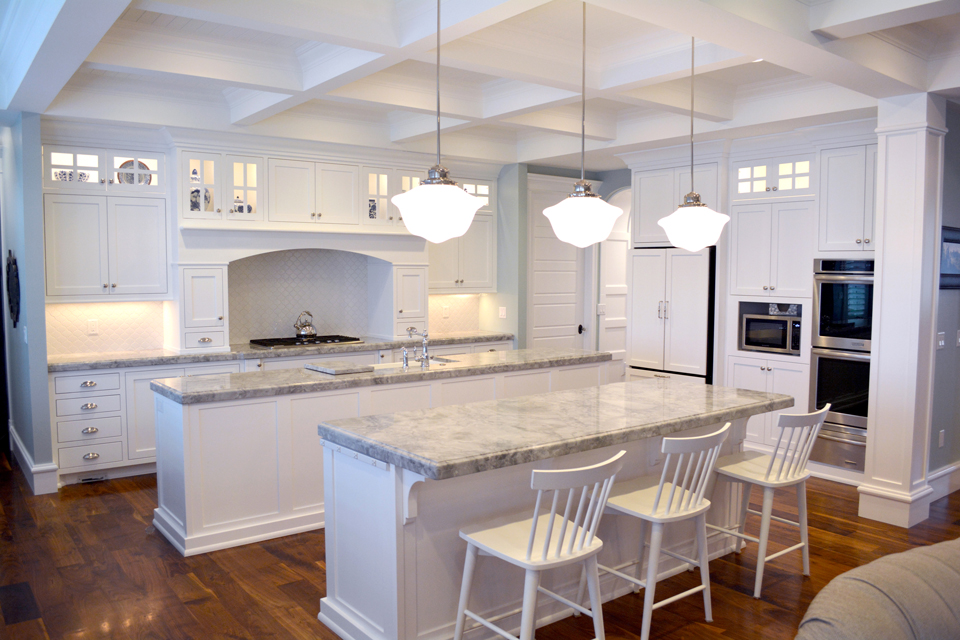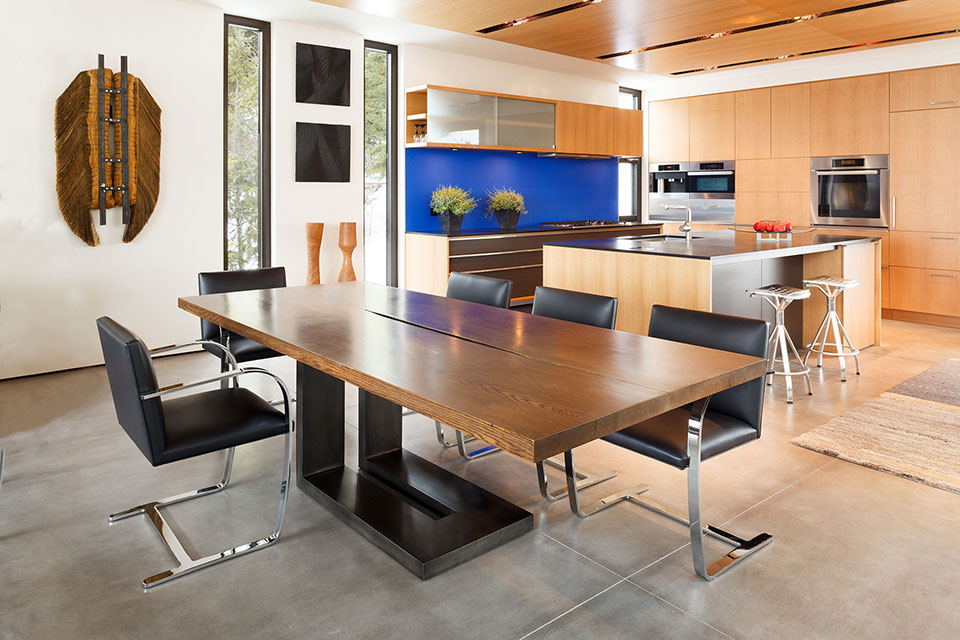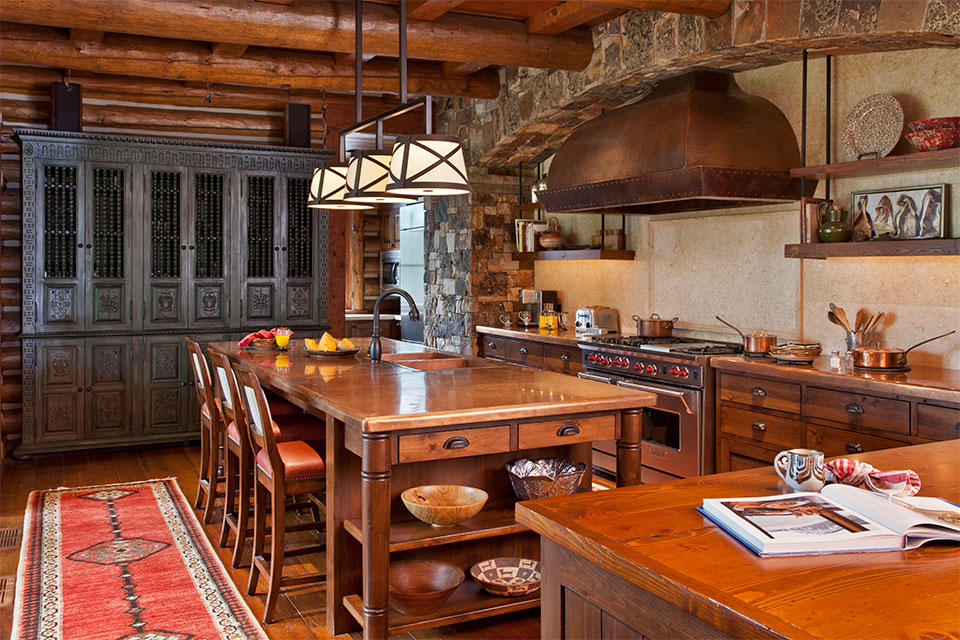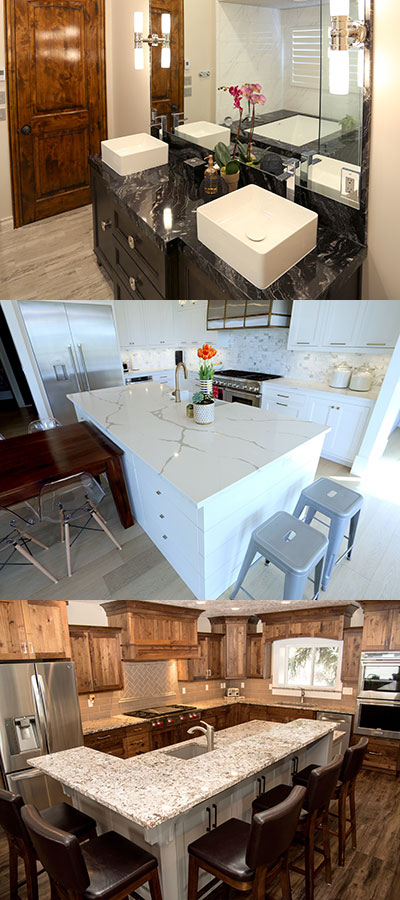How to Customize Countertops
Countertops do more than hold toothbrushes and fruit bowls. We orbit these surfaces each morning and night, DURING MEALS AND AT social EVENTS, making them one of the most used elements of a home.
The practicality of countertops saves us on our busy days by collecting groceries, to-do lists, and soccer jerseys. The aesthetic of countertops presents itself in buffet lines and cocktail parties, while their durability holds the weight of generations of circling family members and late-night conversations.
For all these reasons, choosing the right countertop for a home is no small decision. Today, choices for countertops are driven by necessity and compounded by variety. In the current market, modern technology allows for dozens of high-quality natural and synthetic materials, streamlined fabrication, and custom designs. Virtually anything is available when it comes to color, shape, and durability, while modern mountain style opens the door to several different conceptual opportunities. Within those concepts are the ever-dueling notions of contemporary and traditional design, and how to fit the two snuggly into the mountain landscape. For clients who find this world of possibilities overwhelming, northern Utah’s Evolution Design and Jackson Hole’s Jacque Jenkins-Stireman Design are here to help.
Technology Boosts Customization
Technology has completely revolutionized the countertop industry. From water jet cutting, to digital templates, to accurate, speedy machinery, the customization of giant slabs of natural or manmade materials has never been so accessible. Brett Brunson, owner of Evolution Design in Smithfield, Utah, has had a front row seat for watching the business change in his 20 years in the industry. “Accuracy and quality of fabrication has gone up exponentially with new cutting technology. We can build incredible things by being able to template on a laser and cut on a water jet. There’s no shape or design we can’t accommodate.”
Brunson’s business runs off of his 10,000-square-foot inventory stocked with West Coast natural stone, slab, and purchases from major distribution chains. His work covers the selection, fabrication, cutting, and installation of countertops into new spaces, which allows him to work and customize countertops every step of the way.
Jacque Jenkins-Stireman of Jacque Jenkins-Stireman Design agrees that innovative design has grown as a result of technological advances, particularly when dealing with contemporary design. “There is a level of sophistication within the community of designers, architects, and engineers where there is no shortfall in progressive design, enabling extremely contemporary projects, even in our mountain landscape.” That is, sharp lines, accurate angles, and neutral colors all created against the backdrop of the Tetons.
“With these technologies, we can do anything but do not have to charge more for it,” says Brunson. “We’ve done projects from arched bars to natural-edged looks and have more ability to accommodate the needs of our customers.”
“Accuracy and quality of fabrication has gone up exponentially with new cutting technology…There’s no shape or design we can’t accommodate.”
–Brett Brunson, Evolution Design
Natural Selections Expanded
Innovation doesn’t stop at shape cutting. Jenkins-Stireman alludes to the massive amount of selection available when it comes to the materials themselves. “There are so many ways to get live, beautiful, organic materials. Granite doesn’t always have to be your first go-to. I love quartz and quartzite; I love concrete, soap- stone, and even traditional tile.”
In addition to more traditional natural materials like granite or marble, synthetic material production has massively increased the types of surfaces from which clients can choose. For example, one of the newest products in the industry is porcelain slabs that are imprinted with natural colors and patterns through use of a 3D printer. The final product is a non-porous, scratch-resistant, heat- resistant, and structurally sound surface.
In the same vein, natural quartz products have had an undeniable impact on the market. Engineered quartz consists of mostly ground natural stone mixed with about five percent resin to increase the product’s durability, easy maintenance, and streamlined production. Brunson’s inventory includes the top names in quartz products, such as Caesarstone and PentalQuartz, as well as endless slabs of granite.
However, Jenkins-Stireman has noticed one material gaining ground: “Natural quartzite,” she says. “It looks a lot like marble. It has a different veining than granite and qualities that make it more dense, harder, and durable than granite.” Additionally, that veining neutralizes the boldness of some one-color quartz, settling the countertop into a quieter presence in a space.
“The industry is loaded with specialization,” he says, noting that most other concrete workers only do certain kinds of projects like polishing floors in supermarkets. “I do more than anyone would think. There’s such huge variety, which is incredibly stimulating and fun, even if it means that I have a huge supply of different products and tools to organize.”
“There are so many ways to get live, beautiful, organic materials. Granite doesn’t always have to be your first go-to.”
–Jacque Jenkins-Stireman, Jacque Jenkins-Stireman Design
Defining a Personal Style
While talk of the practicality and durability of a material can make or break a countertop decision, oftentimes these conversations are dominated by a desired aesthetic. Again and again buyers in mountain communities face the juxtaposition of trend and tradition: contemporary versus rustic design. With something so structurally permanent as a countertop, how can a client navigate the sweet spot between style and timelessness? Jenkins-Stireman and Brunson have a few ideas.
As a full-service design firm, Jenkins-Stireman Design works with their clients on a long-term basis. Not only does the team see a project through from start to finish, from breaking ground to turning keys, but the firm also often forms relationships with clients that go well beyond just one project. With an eye on the future, their job is to take abstract concepts like contemporary and craft spaces to fit the personal needs of their clients.
“You have to do a lot more exploring. For example, contemporary can mean something different, depending on the client,” Jenkins-Stireman explains. Before getting to CAD design, paint chips, slab choice, or furniture selection, Jenkins-Stireman gets to know her client and the purpose of their property. Will they be full or part-time residents of Jackson? Are they active? What are they passionate about? Do they have children, grandchildren, a small or a large family? Then come preferences for the line design and material selection.
In homes that are adorned with smart devices…a slab of earthen material can tie a space to its mountain surroundings.
“We don’t really proceed until we get to that place,” says Jenkins-Stireman. “Our process really allows us to hone in on what our clients want and how we can best accomplish their goals.” In particular, however, she looks to respect the integrity of the property while still satisfying her clients. She considers the mountains to be the artwork of a space and looks to create current designs that honor the culture of the landscape.
“The beautiful part of transitioning the contemporary notion into the Mountain West is taking in some of these old, classic, regional, organic materials and milling them into really contemporary clean lines,” says Jenkins-Stireman. “We’re using steel, polished natural stones, local slabs and materials, and are able to envision and fabricate them in a manner that is current and graceful.”
With respect to the countertops he selects and fabricates, Brunson considers how contemporary and traditional designs don’t necessarily have to be mutually exclusive. “We see as much modern design as we do traditional ‘lodge-esque’ Jackson Hole style,” he says. He adds that while most of his fabrication in the area has included straight-edge, flat polished, crisp lines, buyers in the market still prefer materials like Calacatta marble, which has a contemporary look but a small amount of veining to look more natural than pure white quartz.
In that sense, contemporary doesn’t necessarily mean man-made. In homes that are adorned with smart devices, glass walls and windows, sharp lines, and polished edges, a slab of earthen material can tie a space to its mountain surroundings. “We can find anything that looks natural, and will source the best products for our customers,” says Brunson. “But I don’t think that manmade products will replace natural, quarried stone in the future.” He says that he sells equal parts natural to manmade material for a host of designs and concepts, and that one can never beat knowing that their natural stone is one-of-a-kind.
Comfort & Timelessness
“There are so many beautiful solid surfaces,” adds Jenkins-Stireman. “We get hired because what we do is appealing, and anything is possible in a contemporary market. We just have to make sure that at the end of the day, our clients are comfortable at home.”
While current trends thrive and fade, countertops should be built to last and support the wear and movement flowing around them. Ultimately, what will make a current aesthetic timeless is choosing a material and design that fits the needs and lifestyle of a homeowner.
“Traditional style is hard to label, just as contemporary style is hard to label,” says Jenkins-Stireman. “The trick is being able to be current in architecture, technology, and engineering, to take advantage of our natural landscape, and to make clean lines paired with classic tradition. Your personal tradition will never go out of chic.”
When curating her designs, Jenkins-Stireman says she always aims to support a property without over-designing. That is, she wants people to walk into a home and immediately feel comfortable, and not overwhelmed by ornate pieces and loud color schemes. During the start of her design process, she asks her clients what things are meaningful to them, and whether they have favorite artists or family heirlooms and antiques. As she chooses color and material for a surface, she considers what views will be available to the space and what artwork or oriental rugs will be displayed, and she works to integrate those themes and colors into the slab choice so as not to distract from her clients’ personal artifacts.
“I don’t think natural products go out of style,” says Brunson, who sees timelessness in quarried stone. “We can engineer any look that our client wants, but you can’t reproduce the uniqueness of something that comes from the earth.”
Ultimately, the fact that our lives literally revolve around our countertops makes their selection both the hardest and easiest choices in designing a space. True, countertops’ ability to be customized and the variety have reached a pinnacle in which clients can produce exactly the look, color, shape, and material they desire. However, the choices can be made easy by simply looking inward and considering what makes them feels at home.
“That’s the point,” says Jenkins-Stireman. “You want people to walk into their homes and look straight through everything—the furniture, architecture, colors, and angles—and just feel very comfortable and at home.”
With the right materials, colors, concepts, and professionals to fit everyting together, your countertops can accomplish exactly that.
On countertop surfaces, like butcher-block, Edgar will use an oil finish that requires touch-ups from time to time to protect the wood from wear and tear. More ornate pieces like long bars will get a glossier shine. With pine, after letting his piece air dry, he fills any cracks in the surface with epoxy to harden the surface and increase the durability of the wood. The Wise Guy Pizza bar is made of fir and has a nice Varathane finish.
“Your personal tradition will never go out of chic.”
–Jacque Jenkins-Stireman, Jacque Jenkins-Stireman Design
